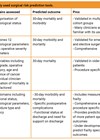The nurse who specialises in continence care is recognised as a key member of interdisciplinary teams seeking to deliver high quality integrated continence services. The recently published international service specifications for continence care [1] supports the use of specialist continence nurses for initial assessment and management of urinary and faecal incontinence, in both nurse-led clinics and specialty services. Such specialists are ideally suited to assume the role of continence case-coordinator recommended in the document.
Specialist continence nurses practise in a variety of settings: urology and urogynaecology clinics, geriatric and other specialty continence clinics, community care and long-term care settings. Nurse-led continence services in the UK have been found to be effective in reducing symptoms, with high patient satisfaction [2]. A qualitative evaluation revealed that interpersonal as well as technical skills (thoroughness, specialisation, knowledge) were important to patient satisfaction [3]. A model of specialty continence nurses working with general practitioners in the primary care setting in the Netherlands was found to be cost-effective [4].
Assessment
Specialist continence nurses are educated to conduct a comprehensive assessment, including history taking, relevant focused physical examination, specific assessment strategies including bladder diaries and measurement of post void residual urine, leading to identification of types of incontinence and pelvic floor disorders, including pelvic organ prolapse. For those in advanced practice, such as nurse practitioners, assessment may include differential diagnosis of common health issues as well as ordering and reviewing laboratory and diagnostic investigations. The unique needs of speciality populations must be considered. One such population is frail older adults, where the effects of polypharmacy, medical co-morbidities, and physical and cognitive function need to be considered in understanding the contributors to incontinence, and creatively identify strategies and solutions with the patient and family.
Conservative approaches first
The expertise of the specialist continence nurse is grounded in conservative management strategies, patient teaching, and care coordination / case management. Knowledge of current evidence-based clinical practice recommendations and guidelines for incontinence is essential to clinical competence in this area.
Lifestyle interventions and self-management (diet, exercise, weight control, smoking cessation, avoiding excess alcohol and coffee) are an important part of initial and ongoing management of incontinence. At the present time, the effect of these on prevention and treatment of incontinence remains unclear [5]. However, it is reasonable to advise on lifestyle as these strategies may reduce or delay the onset of incontinence [6].
Counselling about fluid intake is important. Restricting fluid intake is thought to contribute to urinary incontinence as concentrated urine can irritate the bladder and may also predispose to urinary tract infection [7]. This opposes the popular belief of many people living with urinary incontinence that reducing fluid intake can prevent or improve UI. While anecdotally, intake of adequate fluid intake during the daytime improves urinary incontinence, research in this area has shown inconclusive results. For example, Swithinbank, Hashim and Abrams [8] reported that decreasing fluid intake improved urinary incontinence symptoms, although they cautioned that reduced fluid intake may contribute to constipation, which could worsen incontinence, and so suggested a balance needs to be struck through adequate fluid intake. In the face of inconclusive evidence, continence nurses can suggest adequate fluid intake to be about 1500ml fluid per 24 hours, with most fluid consumed during the day (morning and afternoon), with minimal fluids after supper. Less than a litre of fluid daily puts the individual at risk for dehydration, and greater than three litres is excessive for most people who are not exercising or exposed to high temperatures.
Caffeine is thought to contribute to urinary incontinence as it has a diuretic action and irritant effect. Pharmacologically, caffeine is classified as a methylxanthine, a stimulant with multiple effects in the body including a weak diuretic effect in the kidneys. Although research to support caffeine reduction is limited, general consensus is that it should be considered as a potential contributor, and continence nurses should encourage people with overactive bladder (OAB) symptoms to restrict caffeine to less than 200 mg per day, about two cups of coffee [7].
Helping patients to avoid or improve constipation is essential for continence nurses managing both urinary and faecal incontinence. Constipation is thought to worsen urinary incontinence by pressure of the faecal load on the bladder neck causing obstruction and poor emptying or by exerting pressing on the bladder which can stimulate uncontrolled contraction of the detrusor. Severe constipation can also contribute to faecal incontinence as liquid stool that is hard to control can leak around impacted stool in the rectum, and straining to evacuate the bowels can put stress on the pelvic floor. Unfortunately, evidence on the effect of regulating bowel function in terms of improving incontinence remains absent, with little research undertaken in this area. Despite the lack of clear protocols, it is important that continence nurses teach patients about dietary fibre intake, both soluble and insoluble, and using a footstool to elevate the legs and open the rectum effectively when on the toilet evacuating the bowels.
Pelvic floor muscle training and exercises have been the focus of much research in the prevention and treatment of incontinence in women, and in one group of men, those undergoing radical prostatectomy [6]. Pelvic floor muscle exercises are a mainstay of patient teaching undertaken by the specialist continence nurse. While no one exercise regime has been clearly established as superior to all others, guidelines support a routine of at least eight contractions three times per day of at least three months’ duration as needed to be effective [9]. Although there is less research available to guide practice than there is for pelvic floor muscle exercises, pessaries are another intervention used by specialist continence nurses for women with symptomatic pelvic organ prolapse and stress incontinence. Fitting pessaries is a skill that must be learned under the supervision of another healthcare professional with expertise in this area, and is covered in some but not all specialist education programmes.
Toileting programmes, including prompted voiding, timed toileting and habit training, are behavioural interventions often used by continence nurses to support frail older adults, and frequently require individualised planning and the support of formal and informal (family) caregivers. Although effective in the short-term, these interventions, whether used in an institutional setting such as a nursing or care home, or in the community, are often difficult to sustain due to limitations in caregiver availability or burden of workload. The specialist continence nurse must take these factors into consideration when implementing a toileting programme, and work with caregivers to address expectations and concerns. Bladder training is another behavioural therapy implemented by specialist continence nurses for patients who have the motivation and ability to follow the instructions. A minimum programme length of six weeks should be offered to women with urgency or mixed urinary incontinence [9]. Another important aspect of the role involves helping patients maintain social continence, select continence products to contain and conceal incontinence, and access funding for these products.
Interdisciplinary care is essential in addressing the needs of patients with complex comorbid conditions and functional issues, such as frail older adults or those living with neurological conditions such as Parkinson’s disease or multiple sclerosis. Working in a team-based service with patients and their families, physicians, physical therapists, occupational therapists and social workers facilitates meeting complex patient care needs in continence care.
Pharmacological approaches
Specialist continence nurses in advanced practice, such as nurse practitioners and prescribing nurses, include the prescription of pharmacological interventions as part of incontinence management. There are a variety of titles and education requirements in different countries and jurisdictions for nurses who hold authority to prescribe. Three models of nurse prescribing have been identified: independent prescribing, supplementary prescribing (prescribing partnership between an independent prescriber and a supplementary prescriber to implement a patient-specific clinical management plan) and prescribing based on patient group (supply and administration of specific medications in an identified clinical situation / specific clinical conditions) [10]. Whichever model, nurses assuming responsibility related to prescribing for patients with urinary or faecal incontinence must be knowledgeable about the common medications used in addressing incontinence, and their potential side-effects. Many pharmacological interventions for lower urinary tract symptoms are based on neuroreceptor theory and affect the autonomic nervous system. Preparation in advanced pathophysiology and pharmacotherapeutics, including pharmacodynamics and pharmacokinetics, age-related changes affecting drug treatment, potential drug-drug / drug-food / drug-environment interactions and potential side-effects and adverse reactions is needed to treat patients with pharmacological agents. Additionally, familiarity with recommendations for specialty populations such as the LUTS-FORTA for older adults [11], support safe practice in selection of agents.
Bladder specific antimuscarinics are used to treat urgency and urgency incontinence, key symptoms in overactive bladder. These include tertiary amines oxybutynin, tolterodine, solfenacin, fesoterodine, and darifenacin, and the quaternary amine trospium. All have some risk of anticholinergic side-effects (dry mouth, flushing, confusion), with the oldest agent oxybutynin carrying the greatest risk. The newer agents are more targeted to M3 receptors abundant on bladder wall and in the detrusor and tend to have less systemic anticholinergic effects, although none are bladder-specific. Oxybutynin is poorly tolerated in older adults, and the immediate release formulation is associated with adverse cognitive effects in older people with dementia. It may also adversely affect cognition in those with mild cognitive impairment and normal cognition. It is listed as a D (don’t give) agent in the LUTS-FORTA recommendations. The beta-3 adrenergic agonist mirabegron has recently appeared on the market and been approved in a number of jurisdictions. The theoretical benefit of this drug over antimuscarnics is avoidance of anticholinergics side-effects. Research on its efficacy and safety in special populations, such as older adults and people living with Parkinson’s disease, is ongoing. For severe, intractable urgency and urgency incontinence resistant to antimuscarinic and beta-three agonist treatment, botulinum toxin or sacral nerve stimulation are options, but require urodynamic study and referral to urology by the advanced practice continence nurse.
“Nurses assuming responsibility related to prescribing for patients with urinary or faecal incontinence must be knowledgeable about the common medications used in addressing incontinence, and their potential side-effects.”
Vaginal oestrogens are used for symptomatic urogenital atrophy to improve tissue and restore moisture and normal vaginal pH. They may also improve stress incontinence, urgency and urgency urinary incontinence and recurrent urinary tract infection in older women, although the evidence is inconsistent. Formulations are low dose, and available in vaginal creams (oestriol or conjugated oestrogen), tablet (estradiol-17B) or ring (estradiol-15B). For women who prefer not to use oestrogen, the continence nurse can advise the use of non-oestrogen vaginal moisturisers as an alternative. Interestingly, systemic hormone replacement therapy may worsen stress incontinence in women.
Alpha adrenergic antagonists (tamsulosin, terazosin) and five-alpha reductase inhibitors (finasteride and dutasteride) are used to treat voiding symptoms associated with benign prostatic hyperplasia including hesitancy, intermittency, straining and nocturia. Often an alpha adrenergic agent is used first, as the mechanism of action (relaxation of the sphincter) acts within a few weeks, compared to the months it may take for a five-alpha reductase inhibitor to reduce symptoms.
Recent research on nocturia has revealed this to be a complex condition. Nocturnal polyuria, one cause of nocturia, is defined as more than 20% of 24-hour urine output in young adults, greater than 33% in older adults [12]. Nocturnal polyuria can be due to peripheral oedema, calcium channel blockers, diuretics, sleep apnoea and (possibly) loss of diurnal rhythm of the endogenous hormone arginine vasopressin (antidiuretic hormone) and other factors. If nocturnal polyuria is diagnosed through evaluation of a three-day bladder diary with volume recordings, late afternoon loop diuretic (furosemide) can be tried to induce an evening diuresis, particularly in those with peripheral oedema. However, conservative measures, such as pressure gradiant stockings, should be tried first. Desmopressin, an analogue of vasopressin (antidiuretic hormone) that results in contraction of vascular smooth muscle and stimulation of renal water reabsorption can be considered if diuretic is ineffective. Desmopressin can lead to a dilutional hyponatraemia from water resorption, so serum sodium level must be checked prior to initiation. Older adults with low baseline serum sodium are at higher risk, and it is not recommended for use in frail older adults.
Laxatives are commonly prescribed medications, but often not well understood by those prescribing. There are several classes of laxatives including osmotic agents, stimulants (oral and suppository form), enemas and, for severe opioid induced constipation, opioid receptor antagonists. Little research has been undertaken in laxative use, but most authorities now suggest using an osmotic agent such as polyethylene glycol (PEG 3350) as first line. Recommendations for laxative must go hand in hand with teaching about fluid intake and diet.
Pharmacological strategies are often combined with conservative non-pharmacological interventions. As for conservative approaches, the advanced practice continence nurse works in team-based practice that includes the patient and family in decision making.
Education for nurses seeking to specialise in continence care varies from country to country. In some countries, specialty education has existed for two decades or more. For example, in 1999 Williams and colleagues [13] described a UK education programme for continence nurse practitioners, building on the single course previously offered. In Canada, a university-based continuing education specialty certificate programme for registered nurses was established in 1997 [14]. Enterostomal therapy programmes in the US evolved and expanded to the wound, ostomy and continence nurse specialty [15]. Sweden utilises specialty educated continence nurses [16], and a specialty education programme for nurse practitioners in the Netherlands was developed as part of a research study protocol [17]. In recent years, the International Continence Society Nursing Committee has developed an international role profile of the nurse continence specialist.
Conclusion
The role of the specialist continence nurse is well established in some countries, and growing in others. It is a challenging specialty, with new research informing practice, and opportunity to move into advanced practice roles. I would like to invite specialist continence nurses, as well as those interested in or curious about this exciting area of practice to join us at ICS 2017 in Florence. Opportunities abound to network with nurses and practitioners from other disciplines, learn about new research on conservative as well as pharmacological interventions that make a positive difference in improving quality of life for those living with incontinence.
References
1. Wagg AS, Newman DK, Leichsenring K, van Houten P. Developing an internationally-applicable service specification for continence care: Systematic review, evidence synthesis and expert consensus. PLoS One 2014;9:e104129.
2. Williams KS, Assassa RP, Smith NK, et al. Development, implementation and evaluation of a new nurse led continence service: a pilot study. Journal of Clinical Nursing 2000;9:566-73.
3. Shaw C, Williams K, Assassa RP. Patients’ views of a new nurse-led continence service. Journal of Clinical Nursing 2000;9:574-84.
4. Holtzer-Goor KM, Gaultney JG, van Houten P, et al. Cost effectiveness of including a nurse specialist in the treatment of urinary incontinence in primary care in the Netherlands. PLoS One 2015;10:e0138225.
5. Imamura M, Williams K, Wells M, McGrother C. Lifestyle interventions for the treatment of urinary incontinence in adults. Cochrane Database of Systematic Reviews 2015;12:CD003505.
6. Moore KN, Dumoulin C, Bradley C, et al. ‘Adult Conservative Management’ in Abrams PH, Cardoza L, Khoury AE, Wein A. 5th International Consultation on Urinary Incontinence EAU/ICUD; 2013.
7. Wyman JF, Burgio KL, Newman DK. Practical aspects of lifestyle modifications and behavioural interventions in the treatment of overactive bladder and urgency urinary incontinence. International Journal of Clinical Practice 2009;63:1177-91.
8. Swithinbank L, Hashim H, Abrams P. The effect of fluid intake on urinary symptoms in women. The Journal of Urology 2005;174:187-9.
9. NICE. Urinary incontinence in women: management. NICE Guidelines [CG171] 2013
https://www.nice.org.uk/guidance/cg171
10. Gielen SC, Dekker J, Francke AL, et al. The effects of nurse prescribing: A systematic review. International Journal of Nursing Studies 2014;51:1048-61.
11. Oelke M, Becher K, Castro-Diaz D, et al. Appropriateness of oral drugs for long-term treatment of lower urinary tract symptoms in older persons: Results of a systematic literature review and international consensus validation process (LUTS-FORTA 2014). Age Aging 2015;1-11.
12. Van Kerrebroeck P. Standarization of terminology in nocturia: Commentary on the ICS report. BJU International 2002;90(Suppl 3):16-17.
13. Williams KS, Assassa RP, NKG Smith, et al. Educational preparation: specialist practice in continence care. British Journal of Nursing 1999;8:1202- 7.
14. McMaster University. Nurse Continence Advisor Program
[http://nursing.mcmaster.ca/education_nca.html].
15. Wound Ostomy Continence Nurses
[www.wocn.org].
16. Monz B, Hampel C, Porkess S, et al. A description of health care provision and access to treatment for women with urinary incontinence in Europe: A five country comparison. Maturitas 2005;52b:S3-12.
17. Albers-Heitner P, Berghmans B, Joore M, et al. The effects of involving a nurse practitioner in primary care for adult patients with urinary incontinence: The PromoCon study (Promoting Continence). BMC Health Services Research 2008;8:84.
TAKE HOME MESSAGE
-
Specialist continence nurses are a key team member in delivery of continence services.
-
There is a broad array of conservative measures employed by the specialist continence nurse in working with patients.
-
Advanced practice continence nurses also prescribe pharmacological agents to address patient symptoms. This requires additional education and varies due to legislation in different jurisdictions.
-
Specialist continence nurse education, and the role of the specialist nurse, is established in many countries and growing in others.
 International Continence Society
International Continence Society
Declaration of competing interests:
The author has been a site co-investigator on two industry (Astellas) sponsored clinical trials. However, as a co-investigator, she did not hold any grant funds.






